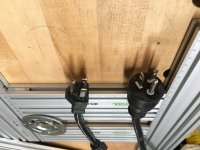Holmz
Member
- Joined
- Oct 11, 2014
- Messages
- 4,001
glass1 said:do people understand how modern electrical breakers work A 15 amp breaker does not limit power to 15 amps but shuts off if the draw is above 15 amps. So if a kapex plugged into a ct plugged into a 15 amp breaker draws more than 15 amps the breaker will pop, it will not continually supply 15 amps even though the appliances try to draw more. My dewalt table saws will sometimes trip a 15 amp breaker on start up and if the table saw is plugged into a ct and a 20 amp breaker it will trip the breaker if anything else is hooked up.The max draw of a kapex is 13 amps. The ct's max draw is similar. But the ct's would only max out under load, a clog or full bag. Am I missing something ? On a side note do the festool ct's need pure sine wave like their tools. Can I run the ct's on the new dealt flex volt battery generator ?
As they seem to fail on regular power, I am not sure the deWalt sine-wave would magically fix it, unless you put a deWalt motor on the Kapex.
And power cleanness seems to be mostly a smoke and mirror distraction from marketing as "alternative-facts"... basically it is "total BS"..., and when compared to working Bosch, deWalt, Makita ...
There is still some possibly of effect on the speed Control, but that seems to be a circuit discussion/effect rather than wires/armature/etc going off to become smoke.
The discussion about the current (non) limiting and circuit breaker 101 is great



